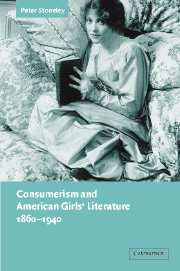6 - Serial pleasures
Published online by Cambridge University Press: 22 September 2009
Summary
Did girls' fiction register turn-of-century crises of overproduction? In part, I have suggested that it did, in that it produced confidently acquisitive heroines. But there were more wholesale changes as well. In other industries, the challenge had shifted from production to consumption, as people had to be encouraged to spend at a rate that would keep pace with industrial productivity. Entrepreneurs and capitalists had to develop the market; they had to “engineer consumption.” There was a growing preoccupation with “forward integration,” as manufacturers took an ever-greater part in retail: in conceptualizing, packaging, and marketing their product. Historians such as Kelly, Ohmann, Scanlon, and others stress the importance of the magazines to this process. Publications like Ladies' Home Journal became an essential “handbook for the middle class,” in that they educated people's tastes, telling them how and why they should spend their money. Aside from advertizing and other forms of product-placement, the magazines had other, more subliminal ways of encouraging a class-ed consumerism. Fiction was important, in that it was intended to reflect and entice the new professional–managerial class that had emerged to create and service the processes of consumption. This quintessentially modern class had pursued a path of “upscale emulation,” and magazine fiction encoded their aspirational desires. The popular romances of the magazines, as Ohmann and others have pointed out, envisaged love-matches across the divide of old and new ruling classes, gratifying emotional longings and class interests at once.
- Type
- Chapter
- Information
- Consumerism and American Girls' Literature, 1860–1940 , pp. 90 - 104Publisher: Cambridge University PressPrint publication year: 2003

